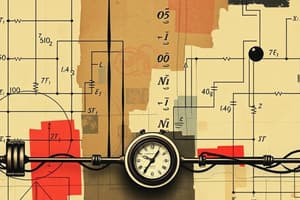Podcast
Questions and Answers
Which of the following statements correctly describes Kirchoff's Current Law?
Which of the following statements correctly describes Kirchoff's Current Law?
- The direction of current flow is not important in calculations.
- The sum of currents entering a junction is greater than the sum of currents leaving.
- Current can be created or destroyed at junctions.
- The total incoming current equals the total outgoing current at a junction. (correct)
What is the modulus of the charge represented by -3 units?
What is the modulus of the charge represented by -3 units?
- -3 units
- 0 units
- Cannot be calculated
- 3 units (correct)
In a situation where an object travels along a path of 150 meters and returns to the starting point, what is the displacement?
In a situation where an object travels along a path of 150 meters and returns to the starting point, what is the displacement?
- 100 meters
- 150 meters
- 0 meters (correct)
- 75 meters
If an object moves in a straight line from point A to point B and then from point B to point C, with distances of 50 meters and 100 meters respectively, what is the total distance covered?
If an object moves in a straight line from point A to point B and then from point B to point C, with distances of 50 meters and 100 meters respectively, what is the total distance covered?
Which of the following best defines a vector quantity?
Which of the following best defines a vector quantity?
What is the fundamental unit for mass?
What is the fundamental unit for mass?
Which of the following is an example of a vector quantity?
Which of the following is an example of a vector quantity?
In the context of units, what does 'MKS' stand for?
In the context of units, what does 'MKS' stand for?
What is the derived unit of speed?
What is the derived unit of speed?
Which of the following statements about tensor quantities is true?
Which of the following statements about tensor quantities is true?
What is the value of sin(π) in a sine wave?
What is the value of sin(π) in a sine wave?
In which system of units is 'foot' a fundamental unit?
In which system of units is 'foot' a fundamental unit?
What can be expressed as a unit vector?
What can be expressed as a unit vector?
Flashcards
Kirchoff's Current Law (KCL)
Kirchoff's Current Law (KCL)
Kirchoff's Current Law (KCL) states that the total current entering a junction (node) in an electrical circuit is equal to the total current leaving the junction.
Distance
Distance
The total path covered by an object, regardless of direction.
Displacement
Displacement
The shortest path between the initial and final points of an object's movement.
Zero Displacement
Zero Displacement
Signup and view all the flashcards
Current (I)
Current (I)
Signup and view all the flashcards
Vector Quantity
Vector Quantity
Signup and view all the flashcards
Scalar Quantity
Scalar Quantity
Signup and view all the flashcards
Unit Vector
Unit Vector
Signup and view all the flashcards
Vector Law of Triangle Addition
Vector Law of Triangle Addition
Signup and view all the flashcards
Magnitude of a Vector
Magnitude of a Vector
Signup and view all the flashcards
MKS System
MKS System
Signup and view all the flashcards
CGS System
CGS System
Signup and view all the flashcards
FPS System
FPS System
Signup and view all the flashcards
Study Notes
CDS/CAPF 2025 Physics Lecture - Unit and Measurement -2
- The lecture covers topics related to units and measurements, as part of the CDS/CAPF 2025 physics syllabus.
- Topics include: quantities (राशियाँ), distance, displacement, velocity, acceleration, dimensional formulas and nomenclature (नामकरण).
Fundamental Units
- Length (L) - unit is meter (m)
- Mass (M) - unit is kilogram (kg)
- Time (T) - unit is second (s)
Derived Units
- Speed - unit is meters per second (m/s)
- Acceleration - unit is meters per second squared (m/s²)
- Force - unit is Newton (N) = kg⋅m/s²
Other Units
- Angle - unit is degree (°), radian (rad) conversion (180° = π rad), and 1 rad = 180°/π = 57.3°
- Amount of substance - unit is mole (mol)
- Luminous intensity - unit is candela (cd)
- Electric current - unit is ampere (A)
- Temperature - unit is Kelvin (K)
- Luminous intensity - unit is candela (cd)
Systems of Units
- FPS (Foot, Pound, Second)
- CGS (Centimeter–gram–second)
- MKS (Meter, Kilogram, Second)
- SI (Système International)
Scalar and Vector Quantities
- Scalar quantities have only magnitude (e.g., mass, speed, distance).
- Vector quantities have both magnitude and direction (e.g., velocity, acceleration, displacement).
Vector Representation
- Vectors are shown using arrows where the length of the arrow represents the magnitude and the arrowhead indicates the direction.
- Vector addition follows the triangle law.
- The resultant of two vectors can be found using the Pythagorean theorem.
Unit Vectors
- Unit vectors have a magnitude of 1
- A vector can be written as the product of its magnitude and unit vector in the direction of the vector.
- Unit vectors along x, y and z axis are î, ĵ and k̂ respectively.
Kinematic and Dynamic Quantities
- Kinematic quantities (like displacement, velocity, acceleration) describe motion without considering the cause of the motion
- Dynamic quantities (like force, momentum, energy) describe motion and the causes of the motion.
Kinematic Concepts
- Distance and displacement
- Speed and velocity
- Acceleration
- Examples related to these concepts are covered
Other Concepts
- Topics on different types of quantities include scalar, vector, tensor
- Different laws are introduced to help calculate the quantities, such as the triangle rule, Kirchhoff's Current Law, Kirchhoff's Voltage Law.
- Examples of these quantities in physics calculations are included.
Problems/Calculations
- Examples and solved problems illustrating the concepts are presented
- Practical applications and examples on calculations are given.
Studying That Suits You
Use AI to generate personalized quizzes and flashcards to suit your learning preferences.




